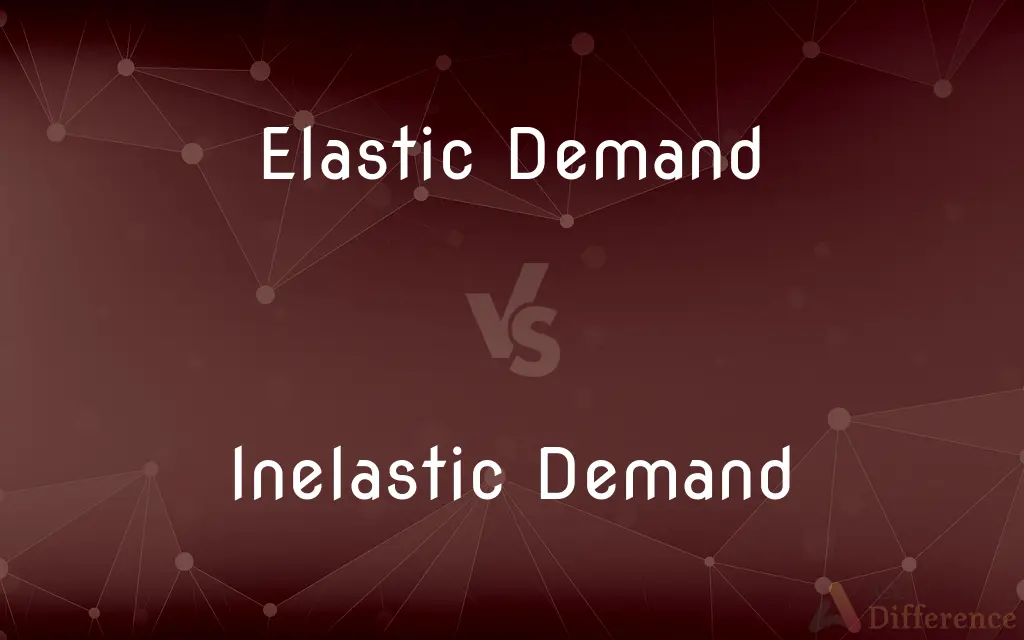Elastic Demand vs. Inelastic Demand — What's the Difference?
By Tayyaba Rehman — Published on October 29, 2023
Elastic Demand is responsive to price changes; Inelastic Demand remains relatively unchanged by price variations.

Difference Between Elastic Demand and Inelastic Demand
Table of Contents
ADVERTISEMENT
Key Differences
Elastic Demand is a concept from economics indicating how sensitive the quantity demanded of a good is to changes in its price. When demand is elastic, even a small change in price leads to a relatively large change in the quantity demanded. Conversely, Inelastic Demand means that the quantity demanded doesn’t change significantly when there are fluctuations in price. Even if the price rises or falls, the demand for the product remains relatively steady.
It signifies that consumers are responsive to price changes. Often, non-essential items, luxury goods, or those with many substitutes exhibit elastic demand. Typically, essential commodities or those without substitutes often have inelastic demand. Items like medication, water, or basic food items often fall under this category.
Comparison Chart
Price Sensitivity
High sensitivity to price changes
Low sensitivity to price changes
Percentage Change
Large % change in quantity demanded
Small % change in quantity demanded
Type of Goods
Non-essential or luxury items
Essential items or few substitutes
ADVERTISEMENT
Consumer Response
Consumers react noticeably to price changes
Consumers relatively unresponsive to price changes
Example Products
Designer clothing, electronics
Medicine, basic food items
Compare with Definitions
Elastic Demand
Sensitive reaction of quantity demanded to price variations.
A small increase in smartphone prices might drastically reduce its elastic demand.
Inelastic Demand
Demand remains stable despite price fluctuations.
Even if bread prices rise, its inelastic demand might remain unchanged.
Elastic Demand
Common for luxury or non-essential products.
Elastic demand for luxury cars means fewer sales when prices rise.
Inelastic Demand
Pertains to essential goods or those with fewer substitutes.
Medicine often has inelastic demand since people need them regardless of cost.
Elastic Demand
Demand changes proportionately more than price.
A 10% rise in soda prices may lead to a 20% decrease in its elastic demand.
Inelastic Demand
Quantity demanded changes less than price changes.
A 10% rise in electricity rates might only lead to a 2% drop in inelastic demand.
Elastic Demand
Often has many available substitutes.
A rise in the price of one brand's coffee can shift elastic demand to another.
Inelastic Demand
Less responsive to market influences.
News about coffee health benefits may not greatly change its inelastic demand.
Elastic Demand
Highly responsive to external market changes.
A favorable review might boost the elastic demand for a novel.
Inelastic Demand
Consumer need rather than want.
Water has inelastic demand; people need it to survive.
Common Curiosities
Are luxury goods always associated with elastic demand?
Often, but not always. Brand loyalty or perceived uniqueness can make them inelastic.
Can a product's demand shift from elastic to inelastic?
Yes, based on factors like emerging substitutes or changing consumer perceptions.
Why is understanding these concepts important for businesses?
It helps in pricing strategies and anticipating revenue changes from price alterations.
Are addictive products typically inelastic?
Often, yes. Despite price changes, consumers might continue purchasing.
Does time influence the elasticity of demand?
Yes, demand might become more elastic over time as consumers find alternatives.
Can government intervention make a product's demand inelastic?
Potentially, through regulations, subsidies, or monopolies.
How does product necessity affect demand elasticity?
Essential products often have inelastic demand since they're needed regardless of price.
What’s the relationship between elasticity and total revenue?
With elastic demand, a price increase could decrease total revenue, while the opposite is true for inelastic demand.
How do substitutes impact elastic demand?
More available substitutes can make a product's demand more elastic.
What role does branding play in elasticity?
Strong branding can make a product's demand more inelastic.
Can both concepts apply to services?
Absolutely. Services, like products, can have elastic or inelastic demand.
Is elastic demand riskier for businesses?
It can be, as sales volumes might fluctuate more with market changes.
How do economic downturns affect demand elasticity?
Typically, more products become elastic as consumers become price-sensitive.
Can promotional offers shift demand elasticity?
Yes, temporary promotions might make demand more elastic in the short term.
How do businesses manage inelastic demand?
They might focus on consistent supply and quality, knowing price changes won't drastically alter sales.
Share Your Discovery

Previous Comparison
Erythritol vs. Splenda
Next Comparison
Kung Fu vs. WushuAuthor Spotlight
Written by
Tayyaba RehmanTayyaba Rehman is a distinguished writer, currently serving as a primary contributor to askdifference.com. As a researcher in semantics and etymology, Tayyaba's passion for the complexity of languages and their distinctions has found a perfect home on the platform. Tayyaba delves into the intricacies of language, distinguishing between commonly confused words and phrases, thereby providing clarity for readers worldwide.
















































